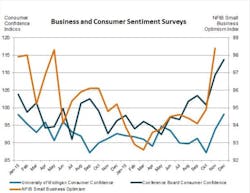Consumer confidence soars in December
Consumer confidence soared in December to its highest level since August 2001, according to the Conference Board. The Consumer Confidence Index jumped from 109.4 in November to 113.7 in December. This mirrored a similar post-election rise in sentiment in the competing survey from the University of Michigan and Thomson Reuters, which rose to levels not seen since January 2004.
More importantly, it continues a trend of surveys showing sentiment rising significantly post-election, including homebuilders, small businesses and manufacturers. Indeed, the Dallas and Richmond Federal Reserve Banks reported expanding manufacturing activity in December for the second straight month on stronger new orders, shipments and production data, and both surveys noted very optimistic outlooks in their respective regions. On the negative side, current hiring levels were soft in both surveys for the month, but employment growth was predicted to accelerate in the first half of 2017.
The U.S. economy grew 3.5 percent at the annual rate in the third quarter, according to revised data, its strongest pace since the third quarter of 2014. That was up from an earlier estimate of 3.2 percent, with the improvement coming from better service-sector spending, nonresidential fixed investment and state and local government spending. Nonetheless, real GDP is expected to increase by just 1.6 percent in 2016, pulled lower by a very weak first half of the year, which grew only 1.1 percent. In addition, fourth-quarter real GDP will likely increase by around 2 percent. The reduced performance in the final quarter of the year stemmed from disappointing consumer spending, durable goods orders and international trade figures, among others. On the latter point, the goods trade deficit jumped significantly in November, likely making net exports a drag on real GDP growth in the fourth quarter. The strong U.S. dollar, which has risen 27.5 percent over the past two and a half years against major currencies, has dampened international demand for goods exports.
Today, we will get a further sense of how rising sentiment has impacted manufacturers with the release of the latest Purchasing Managers’ Index data from the Institute for Supply Management. The November survey results reflected a five-month high, with demand and output experiencing notable improvements. We will see if that expansion will strengthen further in December.
In addition, financial markets will be closely watching the jobs data, which come out on Friday. Nonfarm payrolls have averaged roughly 180,000 per month through the first 11 months of 2016, indicating decent growth overall, with the unemployment rate falling to 4.6 percent, its lowest level since August 2007. However, the data have been choppy at times and not as broad based as we might prefer, especially for manufacturing, which lost 60,000 workers on net year to date. We would expect continued softness in hiring for the sector in December, but employment should begin to pick up in 2017.
Other data highlights this week include new numbers for construction spending as well as factory orders and shipments.
Source: Chad Moutray, Ph.D. CBE, Chief Economist, National Association of Manufacturers (NAM)
